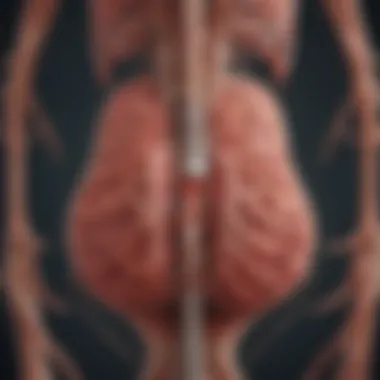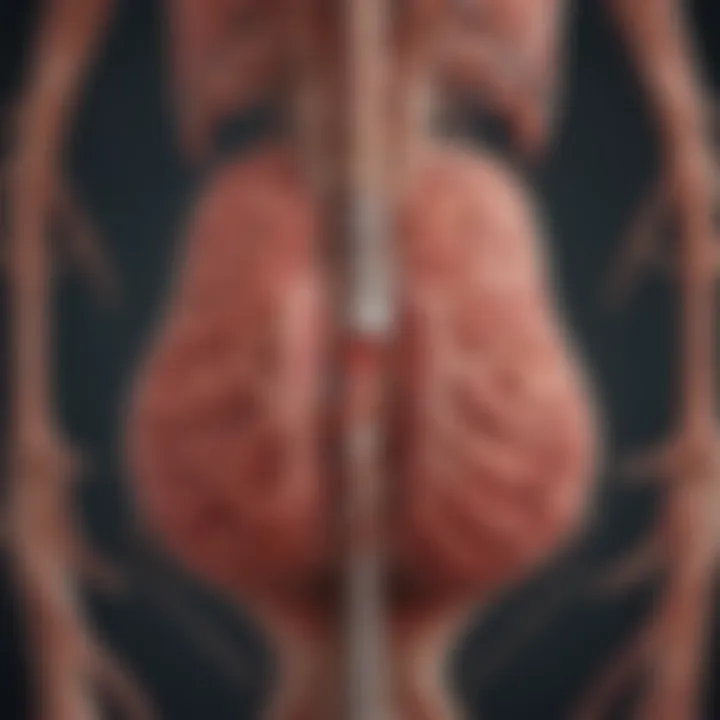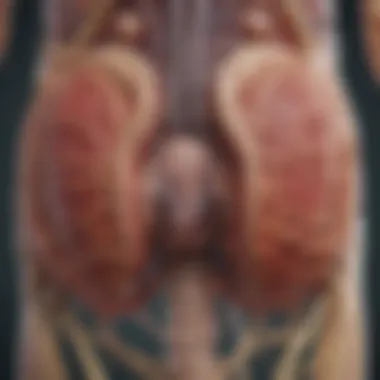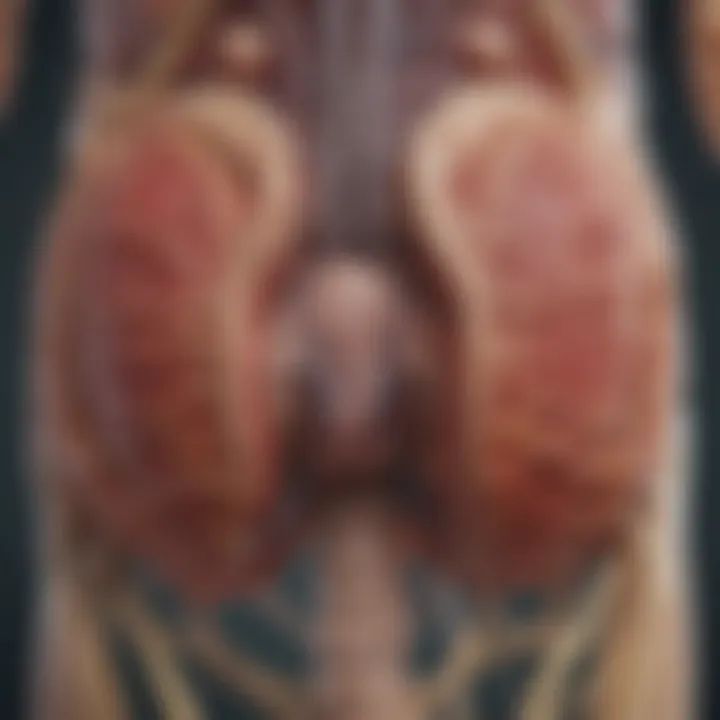Neural Control of the Bladder: Nervous System Insights


Intro
The bladder is a complex organ whose function is intricately linked to the nervous system. Understanding the neural control of the bladder is vital for both health and the treatment of various disorders. This relationship enables the bladder to carry out its essential functions of urine storage and voiding.
The nervous system regulates these processes through several pathways and specific nerves. Both the autonomic and somatic nervous systems play crucial roles in this regulation. Insights into the neuroanatomy of bladder control can lead to better management of urinary issues and improve quality of life for many individuals.
This article aims to clarify key aspects of this relationship, focusing on the nerves involved, pathways of communication, and the implications of this control for health and disease.
Key Findings
- Bladder Innervation: The bladder receives its nerve supply primarily from the pelvic splanchnic nerves. These are responsible for the involuntary functions of the bladder.
- Role of the Spinal Cord: The spinal cord acts as a primary relay center for signals between the bladder and the brain.
- Brain Interaction: Higher brain centers, including the pontine micturition center, play a significant role in the conscious control of bladder emptying.
The combined activities of these nerves and pathways illustrate how the bladder operates smoothly in healthy individuals, balancing storage and voiding requirements. Understanding these mechanisms opens avenues for potential interventions and therapies in cases of dysfunction.
Summary of the main results
The exploration of the nervous system’s influence on bladder behavior highlights not only the complexity of innervation but also the nuances in the communication between various nervous system components. Findings from recent studies emphasize the significance of both the autonomic and somatic nervous systems in maintaining bladder function.
Significance of findings within the scientific community
This research provides fundamental insights that may inform clinical practices and support the development of new treatments. It points the way for future investigations into conditions such as overactive bladder and incontinence, where neural control may be disrupted.
Implications of the Research
Understanding how the nervous system controls the bladder has considerable implications. By analyzing these neural mechanisms, researchers can develop targeted therapies for treating bladder dysfunction.
- Applications of findings in real-world scenarios: The understanding gained from these findings can be applied to develop management strategies for individuals suffering from urinary disorders. Additionally, therapeutic approaches could be tailored based on individual neurological profiles, ensuring more personalized and effective treatment.
- Potential impact on future research directions: Future studies may expand on the current findings, exploring regenerative approaches or neurostimulation techniques that can restore normal function. Innovations in imaging technology might further enhance our knowledge of bladder neuroanatomy and its dysfunctions.
Exploring the intricate relationship between the nervous system and bladder control offers promising avenues for improving health outcomes.
As the field advances, a comprehensive understanding of the neural control of the bladder will play a pivotal role in enhancing patient care and informing health policy.
Foreword to Bladder Control
The understanding of bladder control is a crucial aspect of both basic and clinical science. By examining the complexities of how the nervous system regulates bladder function, one can appreciate the nuances that factor into urinary control. This topic is not solely for specialists in urology; it holds significant value for researchers, medical professionals, and educators who engage with neuroanatomy and physiology.
Exploring bladder control encompasses an array of elements: the structure of the bladder, its connection to the nervous system, and the pathways involved in micturition. Each of these factors ties back to the overarching theme of neural control.
An organized view of how the bladder functions can aid in understanding the various clinical conditions related to bladder dysfunction. Such understanding provides a pathway toward developing effective therapeutic interventions. It is worthwhile to delve into this area, as it can greatly influence patient care and treatment outcomes.
Overview of Bladder Function
The bladder serves as a reservoir for urine; its primary role is to store and expel urine at appropriate times. This storage capability is complemented by the ability to coordinate contractions to initiate urination. The process of filling the bladder activates stretch receptors within its walls, transmitting afferent signals to the nervous system. This feedback loop is essential for both voluntary control and reflexive response to bladder filling.
The bladder is made up of smooth muscle, lined by transitional epithelium, designed for expansion and contraction. When filling occurs, the detrusor muscle relaxes. Upon reaching a certain threshold, the detrusor muscle involuntarily contracts, aided by coordinated actions of various nerves. Understanding these processes is vital for comprehending normal bladder function and disorders associated with it.
Importance of Neural Control
Neural control is paramount in regulating bladder dynamics. The bladder's functions are guided by a complex interplay of the central and peripheral nervous systems. The autonomic and somatic nerves work together to enable voluntary and involuntary responses.
Key aspects of neural control include:
- Autonomic Nervous System: This system coordinates involuntary actions, overseeing functions during bladder filling and emptying.
- Somatic Nervous System: This system enables voluntary control of urination, allowing individuals to decide when to urinate.
In summary, a thorough comprehension of bladder control and its neural basis is essential for improving clinical practices related to bladder dysfunction. It opens avenues for innovative therapeutic strategies, affecting the quality of life for patients with urinary disorders.
"Understanding bladder control provides a necessary context for tackling a multitude of clinical challenges in urology."
By exploring these elements, we lay the groundwork for a detailed investigation into the anatomy, pathways, and mechanisms involved in bladder function.
Anatomy of the Bladder
Understanding the anatomy of the bladder is essential to grasp its connection with neural control. The bladder is a muscular, hollow organ responsible for storing urine until it is expelled from the body. Its unique design not only aids in functionality but also plays a significant role in how the nervous system regulates its activities. The bladder's capacity and elasticity are important factors that impact how signals are sent to and from the nervous system, thereby influencing bladder behavior and control.
Bladder Structure
The bladder consists of several key layers that contribute to its function. The detrusor muscle forms the muscular wall. This smooth muscle layer is crucial for the contraction process during urination. The mucosa, the innermost layer, is lined by transitional epithelium, which is capable of stretching as the bladder fills. This unique property helps accommodate different urine volumes.
Additionally, the adventitia surrounds the bladder, providing structural support and helping to anchor it within the pelvic cavity. Each of these layers interacts with the nervous system, allowing precise control over bladder filling and release. This close relationship emphasizes the importance of understanding bladder structure in the study of neural control.


Histological Features
The histological characteristics of the bladder are also worth noting. The transitional epithelium allows for significant expansion without compromising the integrity of the bladder wall. This layer comprises multiple cell layers that flatten out as the bladder fills.
The smooth muscle cells of the detrusor muscle have a unique arrangement. They are organized in a mesh-like formation, allowing for coordinated contractions during micturition. This complexity in structure relates directly to how neural signals control bladder function.
Understanding these histological features provides insight into how disorders may arise. For instance, alterations in the muscular or epithelial layers could lead to dysfunctions such as incontinence or urinary retention. These potential issues highlight the importance of anatomy in clinical settings—showing how knowledge can aid in diagnosing and treating bladder-related conditions.
The Nervous System Overview
The nervous system plays a crucial role in regulating bladder function. It serves as the communication network that facilitates bladder control, linking both voluntary and involuntary actions. Understanding its components provides insight into bladder behavior and its implications in various medical conditions. The intersection of neural mechanisms with bladder activity is fundamental for both physiological processes and the management of disorders related to bladder dysfunction.
Central Nervous System
The Central Nervous System (CNS) encompasses the brain and spinal cord, acting as the main control center for the whole body. In terms of bladder control, the CNS is responsible for integrating sensory information from the bladder and coordinating appropriate responses. This involves processing signals regarding bladder fullness and initiating the desire to urinate.
Within the CNS, certain regions play specific roles. The Kinesitic cortex, for instance, assesses when it is suitable to engage in micturition by evaluating both internal and external cues. Neurotransmitters also play a key role in this processing, impacting the action of nerve signals and thus influencing bladder activity.
In urgent situations, the brain's ability to inhibit or promote urination is paramount. This dual function showcases the CNS's critical role in both voluntary and involuntary aspects of bladder control.
Peripheral Nervous System
The Peripheral Nervous System (PNS) consists of all nerves outside the CNS and is integral to bladder control by relaying information between the bladder and CNS. It is divided into two main parts: the autonomic nervous system and the somatic nervous system.
The autonomic nervous system further splits into sympathetic and parasympathetic divisions. The sympathetic division generally inhibits bladder contractions, preparing the body for 'fight or flight' responses. In contrast, the parasympathetic division promotes bladder contraction, leading to urination.
The somatic nervous system, through the pudendal nerve, aids in the voluntary control of the external urethral sphincter, allowing conscious regulation of urination. This coordination between the CNS and PNS is vital in managing both bladder storage and release cycles. Together, these systems enable the appropriate interplay of signals that facilitate a healthy bladder function.
Nerves Involved in Bladder Control
Understanding the nerves involved in bladder control is essential for grasping how the urinary system functions. The bladder, a muscular organ, relies heavily on neural signals to manage storage and voiding. Thus, disturbances to these nerve pathways can lead to various dysfunctions. Recognizing the roles of these nerves helps in developing therapeutic strategies for individuals facing bladder issues.
Autonomic Nervous System
The autonomic nervous system (ANS) plays a crucial role in regulating bladder functions. It is divided into two main components: the sympathetic and parasympathetic nervous systems.
- Sympathetic Nervous System: During the filling phase of the bladder, sympathetic pathways inhibit bladder contraction and stimulate the storage of urine. This is critical for allowing the bladder to hold urine until appropriate conditions arise for voiding.
- Parasympathetic Nervous System: Contrarily, when it is time to urinate, the parasympathetic system activates. This leads to bladder muscle contraction and relaxation of the internal sphincter, facilitating urination.
The balance between these two systems determines the bladder's behavior under various conditions. A disruption in this balance can manifest in conditions like overactive bladder or urinary incontinence, which underlines the importance of each system's contributions.
Somatic Nervous System
The somatic nervous system (SNS) encompasses nerves that control voluntary actions. In the context of bladder control, it primarily involves the pudendal nerve. This nerve is responsible for the conscious control over the external urethral sphincter.
- The pudendal nerve allows individuals to consciously decide when to start or stop urination. This voluntary effort requires a higher locus of control within the central nervous system.
- Issues within the somatic nervous system can lead to problems such as inability to control urination or retention.
In summary, both the autonomic and somatic nervous systems have critical roles in bladder control. By understanding these systems, professionals can better address disorders related to bladder dysfunction, enhancing quality of life for affected individuals.
Autonomic Nerves and Their Roles
Autonomic nerves play a crucial role in regulating bladder function. These nerves are responsible for the involuntary control of bladder activities, which means they operate without conscious effort. Understanding the distinction between the sympathetic and parasympathetic nerves within the autonomic nervous system is essential. Each set of nerves has specific effects on bladder control, which impacts overall urinary health. Recognizing these roles also informs clinical approaches to bladder dysfunction and treatment options. This awareness contributes to a comprehensive grasp of how the body maintains bladder function and responds to various stimuli.
Sympathetic Nerves
The sympathetic nerves are primarily involved in the body's "fight or flight" response. When activated, these nerves inhibit bladder contraction and facilitate urine storage. The sympathetic nervous system uses neurotransmitters like norepinephrine to achieve this effect. It innervates the detrusor muscle, which relaxes the bladder and reduces pressure. Additionally, sympathetic stimulation helps contract the internal urethral sphincter to maintain continence.
Some key aspects of sympathetic nerve function include:
- Control of Detrusor Muscle: The sympathetic nerves prevent premature bladder contraction, which is particularly important during stressful situations.
- Enhancement of Storage Capacity: By keeping the bladder relaxed, the sympathetic system supports the bladder in holding urine until it can be discarded safely.
- Response to Stress: During stress or increased physical demands, sympathetic activation ensures that urine is not expelled until it is safe to do so.
Parasympathetic Nerves
In contrast, the parasympathetic nerves play a pivotal role during urination. This branch of the autonomic nervous system promotes bladder contraction and the expulsion of urine. When the bladder is full, stretch receptors signal the parasympathetic neurons, leading to the release of acetylcholine. This neurotransmitter binds to receptors in the detrusor muscle, inducing contraction.
Key functions of parasympathetic nerve activity include:
- Facilitating Micturition: The primary role of this nerve activity is to trigger the micturition reflex, allowing for the conscious and voluntary release of urine.
- Coordination with Afferent Signals: Parasympathetic nerves work in conjunction with sensory inputs from the bladder to assess when it is appropriate to urinate.
- Promotion of Bladder Emptying: Once activated, these nerves ensure efficient and complete bladder emptying, which is essential for maintaining urinary health.
"Understanding the roles of sympathetic and parasympathetic nerves in bladder control enhances our ability to address urinary disorders effectively."


Somatic Nerves and Their Contributions
Somatic nerves play a significant role in the complex systems governing bladder control. Unlike the autonomic nervous system, which handles involuntary functions, the somatic nervous system allows for conscious control over certain actions related to bladder function. Understanding these contributions provides insight into how various nerve pathways affect bladder behavior, specifically regarding voluntary control.
Pudendal Nerve
The pudendal nerve is the primary somatic nerve responsible for the voluntary control of the external urethral sphincter. This control is crucial for maintaining continence. Activation of the pudendal nerve allows individuals to consciously contract the sphincter, which prevents urine from passing during times they are not ready to void.
This nerve arises from the sacral region of the spinal cord and travels through the pelvis to reach the perineum. Its proper functioning is essential in both men and women. Damage to the pudendal nerve may result in reduced control over urination or even incontinence. Thus, therapies targeting pudendal nerve integrity and function are critical in managing bladder disorders.
Motor Control
Motor control of the bladder involves the coordination of both somatic and autonomic pathways. While autonomic nerves regulate bladder filling and emptying independently, somatic nerves provide the mechanism for voluntary control. This interaction is vital during the storage phase of bladder function, where the bladder fills and the individual has to decide when to void.
Successful motor control requires a balance between these systems. If the autonomic system stimulates bladder contraction, the somatic system must, in turn, signal closure of the sphincter. This intricacy highlights the need for precise and effective communication between somatic and autonomic functions.
Clinically, understanding this dynamic aids in developing treatments for conditions such as overactive bladder and urge incontinence. Moreover, rehabilitation therapies often incorporate strategies to enhance motor control, demonstrating the practical importance of the knowledge surrounding somatic nerves.
To summarize, the somatic nerves, particularly the pudendal nerve, are integral to voluntary bladder control. They allow individuals to regulate urination consciously, which has profound implications for quality of life and health. High-functioning motor control mechanisms ensure that people can maintain bladder integrity and participate actively in their daily activities, thereby reducing the burden of bladder dysfunction.
Neural Pathways in Bladder Function
Understanding the neural pathways involved in bladder function is critical for grasping how the nervous system regulates urinary behavior. These pathways facilitate communication between the bladder and the central nervous system, allowing for timely responses to the physiological needs of the body. They include both efferent and afferent pathways, which work closely together to ensure proper bladder control and function.
Efferent Pathways
Efferent pathways are essential for bladder control as they transmit signals from the brain to the bladder. This process allows the bladder to either contract or relax, determining whether urine is expelled or retained. The primary nerves involved include the sympathetic and parasympathetic autonomic fibers.
- Sympathetic Pathways: These nerves play a role in bladder storage by inhibiting contraction. The thoracolumbar region of the spinal cord initiates sympathetic stimulation. This pathway releases norepinephrine, which binds to adrenergic receptors, facilitating bladder filling.
- Parasympathetic Pathways: Originating from the sacral region of the spinal cord, these pathways are crucial for micturition. When activated, they stimulate bladder contraction. Acetylcholine is released, which activates muscarinic receptors on the bladder smooth muscle, triggering urination.
The coordination between these pathways reflects a balance between storing urine and expelling it during appropriate times. Disruptions in efferent pathways can lead to serious urinary disorders, highlighting their clinical significance.
Afferent Pathways
Afferent pathways represent the sensory aspect of bladder control, sending information from the bladder back to the brain. These pathways are responsible for signaling when the bladder is filling and when it reaches capacity. The key components include:
- Stretch Receptors: Located in the bladder wall, these receptors are sensitive to the degree of distension. As the bladder fills, they send continuous signals through afferent nerves to inform the brain of bladder status.
- Pelvic Nerves: These carry sensory information from the bladder to the spinal cord, providing crucial data about fullness. When stretch receptors detect reaching the threshold, the sensation of urgency is communicated to the central nervous system.
- Reflex Arcs: Involvement of reflexes further enhances the speed and efficiency of responses involved in urination. The integration of afferent signals allows the body to coordinate appropriate muscle responses for micturition.
Understanding afferent pathways is also significant in clinical contexts. Conditions that affect sensory transmission can lead to incontinence or inability to sense fullness, resulting in adverse health outcomes.
In summary, both efferent and afferent pathways are vital for bladder control and function. They illustrate a complex interaction between brain signals and bladder responses, showcasing the intricate nature of neuroanatomy in urology.
Reflexes Involved in Urination
Understanding the reflexes that are involved in urination is crucial to comprehending the overall neural control of bladder function. These reflexes play a significant role in coordinating the physiological responses necessary for effective bladder emptying. The main reflex associated with this process is the micturition reflex, which integrates a complex interaction between various neural structures and pathways.
Micturition Reflex
The micturition reflex is an involuntary response that primarily facilitates the act of urination. This reflex involves signals sent from the bladder to the spinal cord and then back to the bladder to initiate contraction and relaxation. When the bladder fills with urine, stretch receptors within the bladder wall detect the increase in volume. This information is relayed to the spinal cord, where it activates the autonomic nervous system to trigger contractions of the detrusor muscle.
The orchestration of these contractions allows the bladder to empty. A critical component of this reflex involves both the sympathetic and parasympathetic pathways. The sympathetic nerves inhibit bladder contraction during the filling phase, whereas the parasympathetic nerves promote contraction during the voiding phase. This balance is essential for bladder control and effective urination.
Role of Stretch Receptors
Stretch receptors are specialized sensory neurons located in the bladder wall. They play an essential role in monitoring the fullness of the bladder. As the bladder fills, these receptors become increasingly activated, sending signals to the central nervous system about the current bladder volume. The information helps to determine when the bladder is full enough to initiate urination.
The stretch receptors influence the micturition reflex significantly. When a threshold volume is reached, the signals from the stretch receptors help trigger the urge to urinate. This communication is vital, as it enables the body to coordinate bladder contractions and relaxations effectively. Understanding the precise function of these receptors sheds light on various disorders that can affect bladder control.
Key Point: The micturition reflex and the role of stretch receptors are central to bladder function. Their interaction ensures that urination occurs efficiently and at appropriate times.
In summary, the reflexes involved in urination highlight the intricate relationships between the bladder, its neural control, and the physiological mechanisms that regulate this fundamental process. Recognizing these connections helps clarify the complexities of bladder disorders and the implications for treatment.
Influencing Factors on Bladder Control
The functioning of the bladder is a complex interplay of various elements. The factors influencing bladder control are significant, as they directly affect both autonomic and somatic functions. Understanding these elements enhances the grasp of bladder behavior, providing insights into how different conditions can alter normal urinary function.
Neurological Conditions
Neurological conditions can have a profound impact on bladder control. Disorders such as multiple sclerosis, Parkinson’s disease, and spinal cord injuries can disrupt normal nerve pathways. These disruptions may lead to symptoms like urgency, incontinence, or retention. In cases of multiple sclerosis, for instance, the myelin sheath insulating nerve fibers may become damaged, hindering effective communication between the bladder and the brain.


Further, conditions like stroke can also affect bladder control, resulting in potential loss of voluntary control. This can lead to increased dependency on caregivers and can significantly lower the quality of life for affected individuals. Understanding these conditions is crucial for developing effective therapeutic interventions.
- Impact of Neurological Conditions:
- Impaired communication between the bladder and brain.
- Reduced ability to control urination.
- Increased risk for urinary tract infections.
Aging and Bladder Function
Aging is another critical factor affecting bladder control. As individuals age, various physiological changes occur. Muscle tone in the bladder and pelvic floor may decrease, leading to common issues like urinary incontinence or increased frequency of urination. Moreover, older adults may experience a reduced ability to empty the bladder completely, potentially leading to retention and other complications.
Research suggests that the aging process can also alter the sensitivity of the bladder wall and the coordination of the bladder and sphincter muscles. These changes can significantly impact life quality and require special attention in clinical practices.
The interplay of aging and neurological health is essential to preserve bladder functions and optimize patient care.
In summary, both neurological conditions and aging present distinct challenges to bladder control. Recognition of these influencing factors enables health professionals to tailor treatment plans effectively, improving patient outcomes.
Clinical Implications of Nerve Control
Understanding the neural control of the bladder has significant clinical implications. This knowledge is essential for diagnosing and treating various bladder dysfunctions and disorders. The interplay between the nervous system and bladder function reveals insights into how different conditions may alter normal behavior. Recognizing these links helps in developing effective management strategies for patients.
Disorders of Bladder Function
Bladder dysfunction can be categorized into several disorders that stem from neural control issues. These include:
- Overactive Bladder (OAB): Characterized by urgency and frequent urination, OAB can significantly impact a patient's quality of life. It often results from inappropriate signaling in the nervous system.
- Underactive Bladder: This condition leads to difficulty in urination and incomplete emptying. The neural pathways that facilitate bladder contraction may be impaired, causing distress for affected individuals.
- Neurogenic Bladder: Conditions such as multiple sclerosis or spinal cord injury can lead to neurogenic bladder. This condition arises when the brain cannot properly communicate with the bladder, resulting in dysfunction.
- Incontinence: Various types of incontinence, such as stress urinary incontinence, occur when signals controlling bladder closure during physical activity fail.
Understanding these disorders is critical. By recognizing the neuroanatomical basis of these conditions, clinicians can tailor interventions to restore normal function or mitigate symptoms effectively.
Therapeutic Approaches
Treatment strategies for bladder dysfunction focus on addressing the underlying neural issues. They can include:
- Behavioral Therapies: These approaches aim to modify lifestyle and habits. Patients can learn bladder training techniques and urge control strategies. This often improves symptoms without medication.
- Medications: Various pharmacological agents target the autonomic nervous system. Anticholinergics, for instance, are often prescribed for OAB to reduce involuntary contractions.
- Neuromodulation Therapy: Techniques like sacral neuromodulation can be employed. This involves stimulating the sacral nerves to improve bladder function through electrical impulses.
- Surgery: In severe cases, surgical options may be considered. These can include procedures to augment bladder capacity or to create a new means of bladder drainage.
Effective treatment relies on understanding the specific neural mechanisms at play in each patient’s bladder dysfunction.
Understanding these therapeutic approaches helps pave the way for innovations in treatment methodologies. As research progresses, it opens the door for potential advancements that could lead to more effective and personalized care for patients.
Research Directions in Neuroscience and Urology
The intersection of neuroscience and urology is a burgeoning area of study, particularly concerning the neural control of the bladder. Understanding this connection aids in addressing various disorders that affect bladder function, embracing the complexities of both autonomic and somatic nervous systems. This exploration brings clarity to how neuronal pathways and sensory feedback mechanisms contribute to bladder control. Moreover, it opens up new pathways to innovative treatments and management strategies for urinary disorders. The importance cannot be overstated, as it is not only crucial for enhancing patient care but also for pushing the boundaries of scientific inquiry in both fields.
Current Studies on Bladder Control
Current research into bladder control primarily focuses on elucidating specific neuronal circuits and their roles. For instance, studies are examining the function of specific receptors and neurotransmitters within the bladder wall. Researchers are also investigating how changes in bladder nerve function can lead to overactive bladder symptoms or urinary retention. Experimental studies often utilize animal models to grasp the intricacies of these pathways.
Key research areas include:
- Neurotransmitter Role: Investigating how neurotransmitters influence bladder contractions.
- Receptor Mapping: Identifying which receptors are involved in bladder signaling, including muscarinic and adrenoceptors.
- Pathway Disruption: Assessing how lesions in specific pathways can affect bladder control.
The findings from these studies are paving the way for targeted therapies aimed at restoring normal bladder function. By understanding the specific roles of various neural components, researchers hope to develop interventions that specifically correct dysfunctions.
Future Perspectives
Looking ahead, the future of research in the neural control of the bladder holds promise. The integration of advanced technologies, such as optogenetics and functional imaging, allows for a more profound understanding of the neural mechanisms involved. It could facilitate more personalized approaches to treatment, tailored to individual patient needs.
Moreover, future exploration may lead to:
- Better Therapeutics: Development of drugs that can more precisely target specific receptors or pathways.
- Biofeedback Methods: Enhanced techniques for managing bladder conditions through nerve stimulation or training.
- Interdisciplinary Research: Collaboration between neurology, urology, and rehabilitation sciences to address complex bladder issues holistically.
Research efforts are gradually shifting towards an integrative approach, placing equal emphasis on both the neuroanatomical and behavioral components of bladder control. This shift bears great potential for improving life quality for individuals suffering from bladder dysfunctions.
"The combination of innovative research techniques and interprofessional collaboration stands to revolutionize our understanding and treatment of bladder control disorders."
Closure
The neural control of the bladder is an intricate system that plays a pivotal role in urination and overall urinary health. Understanding this topic is essential for both medical professionals and researchers. It highlights how the autonomic and somatic nervous systems interact, impacting not only bladder function but also aspects of patient care in various clinical situations.
Summary of Key Points
- Neural Pathways: Key nerves involved in bladder control include both autonomic and somatic nerves, which serve distinct but interrelated functions in bladder management.
- Reflexes: The micturition reflex is fundamental to the bladder’s functioning. It involves complex feedback loops, essential for voluntary control.
- Influencing Factors: Neurological conditions and aging can significantly alter bladder control, indicating the need for tailored therapeutic approaches in these populations.
- Clinical Relevance: Disorders affecting bladder control, such as overactive bladder or neurogenic bladder, can have a profound impact on quality of life, necessitating a comprehensive understanding of its neural basis.
Importance of Understanding Nerve Function
Understanding nerve function in bladder control is valuable for several reasons. It provides insights into how disturbances in the nervous system can lead to bladder dysfunction. This understanding aids in developing effective treatments, improving diagnostics, and fostering research into novel therapeutic strategies. Furthermore, insights into nerve functions can enhance patient education, enabling individuals to comprehend their conditions better.
In summary, a thorough grasp of the neural mechanisms governing bladder control is indispensable for advancing both clinical practices and research in urology and neuroscience. It is a critical pathway for understanding not just bladder function, but its wider implications on human health.







